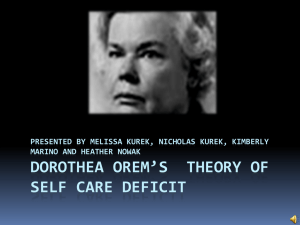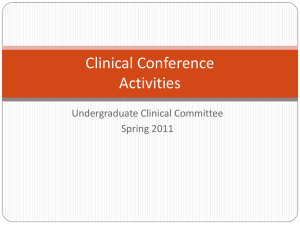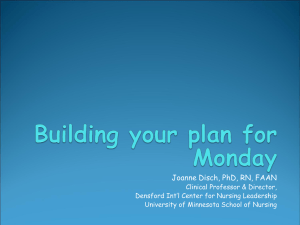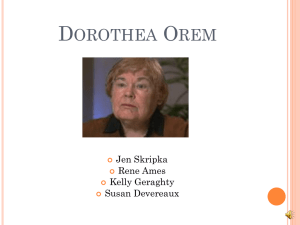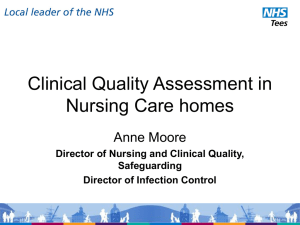Dorothea Orem's Self-Care Deficit Theory Presentation
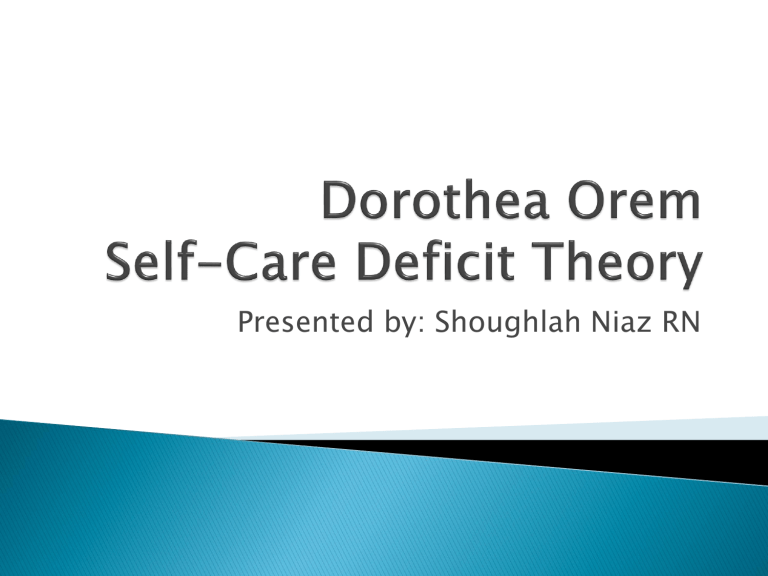
Presented by: Shoughlah Niaz RN
•
Born in Baltimore, MD in 1914
•
Began Nursing Career in Providence Hospital in Washington DC, received her nursing diploma
•
Complete BSN in 1939 and her MSN in 1946 at
•
Catholic University of America
•
Held Directorship of nursing school and nursing department at
Providence Hospital in Detroit from 1940-1949
•
Moved to Indiana and worked for the Indiana State Board of Health
(Biography of Dorothea Orem, 2013)
•
•
•
•
•
•
•
Moved to Washington DC in 1957 at the US Dept of Health as a curriculum consultant to upgrade nursing training
Became Assistant Professor at Catholic University of America in 1959
Developed her concepts of nursing and self care at Catholic
University of America
Began consulting firm in 1970
Published first book in 1971 “Nursing: Concepts of Practice”
Honorary Doctorates
Died in 2007
(Biography of Dorothea Orem, 2013)
•
Developed theory to improve quality of nursing and patient ability to meets demands of care
•
Three components of theory:
•
•
•
Self-care
Self-care deficit
Nursing System
•
•
Self-care deficit is core of Orem’s theory because determines when nursing is needed
Main purpose for theory is for patients and families to maintain control of health by actively performing for self
(Self Care Deficit of Nursing Theory-Dorothea Orem, 2012)
•
Activity of person to do on own in maintaining their health and well-being
•
When there is demand to care for oneself and that individual is capable to meet that demand, self-care is possible
•
Concepts:
-Self care agency
-Therapeutic self care demand
-Self care requisites: universal, developmental and health deviation
(Self Care Deficit of Nursing Theory-Dorothea Orem, 2012)
•
•
•
When individual is not capable to meet the demand of care for self, self-care deficit occurs
This is the key to Orem’s theory
Nursing is required in self-care deficit to guide in meeting the demand
•
•
•
•
•
•
5 methods of helping:
Acting for or doing for patient
Teaching patient
Directing patient
Supporting patient
Providing environment for patient
(Self Care Deficit of Nursing Theory-Dorothea Orem, 2012)
•
Addresses and plans how needs of the patient can be met by the nurse, patient and/or both
•
•
Three types:
Wholly compensatory system-patients not capable to perform self-care
•
Partly compensatory system-limited mobility due to illness
•
Supportive-educative system-patient is capable of learning to perform
(Moore, 2013)
•
•
•
To help and promote patient to perform selfcare
Patient can recover faster if they are encouraged to perform self-care tasks to maintain their health and well-being
Theory can apply to all types of nursing ex: rehab, primary care settings, nursing home and elders
(Self-Care Deficit Theory, 2013)
Retrieved:https://sites.google.com/site/oremstheory/description-of-the-model
•
•
•
•
•
•
•
Geriatric patients- restortative programs
Physical, occupational and speech therapy active ROM can facilitate building strength
Walking- to maintain physical health
ADLs
Staying active
Nurse can meet needs of patients with setting goals and interventions
Retrieved from:http://www.agefotostock.com/en/Stock-Images/Low-Budget-
Royalty-Free/ESY-000850465
Biography of Dorothea Orem (2013). Retrieved on October 05, 2013. http://nursingtheories.info/biography-of-dorothea-orem/
Moore, C. (2013). Dorothea Orem’s Self-Care Requisites. Retrieved on October 05, 2013.
http://www.bellaonline.org/articles/art57906.asp
Self Care Deficit of Nursing Theory-Dorothea Orem. Retreived on October 05, 2013.
http://fundamentalsnursing.com/self-care-deficit-of-nursing-theory-dorothea-orem
Self Care Deficit Theory (2013). Retrieved on October 03, 2013
. http://nursing-theory.org/theories-and-models/orem-self-care-deficit-theory.php
